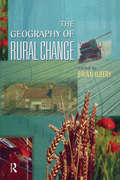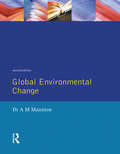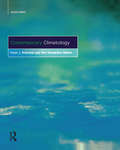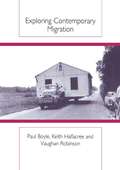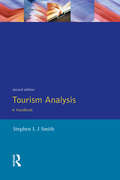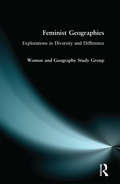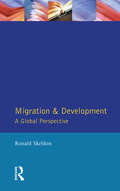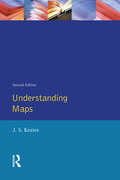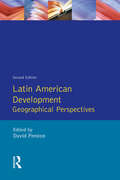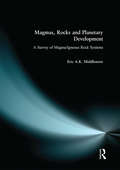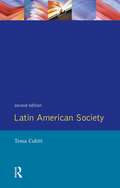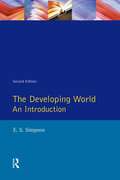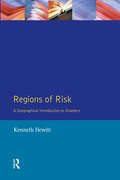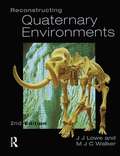- Table View
- List View
The Geography of Rural Change
by Brian IlberyThe Geography of Rural Change provides a thorough examination of the processes and outcomes of rural change as a result of a period of major restructuring in developed market economies. After outlining the main dimensions of rural change, the book progresses from a discussion of theoretical insights into rural restructuring to a consideration of both the extensive use of rural land and the changing nature of rural economy and society. The text places an emphasis on relevant principles, concepts and theories of rural change, and these are supported by extensive case study evidence drawn from different parts of the developed world.The Geography of Rural Change is written for undergraduates taking courses in human geography, agricultural geography, rural geography, rural sociology, planning and agricultural economics.
Global Environmental Change: A Natural and Cultural Environmental History
by Antoinette MannionNow in its second edition. This text has been extensively revised and rewritten to reflect the growth in environmental research during the last decade. Human-induced environmental change is occurring at such a rapid rate that, inevitably, the fundamental processes involved in biogeochemical cycling are being altered. Global Environmental Change considers alterations to the biogeochemical cycles of carbon, nitrogen, sulphur and other elements as a result of industrial/technological development and agriculture, which have significantly altered the natural environment. The book adopts a temporal and spatial approach to environmental change, beginning with the natural environmental change of the Quaternery period and continuing with the culturally-induced change since the inception of agriculture 10,000 years ago.
Global Environmental Change: A Natural and Cultural Environmental History
by Antoinette MannionNow in its second edition. This text has been extensively revised and rewritten to reflect the growth in environmental research during the last decade. Human-induced environmental change is occurring at such a rapid rate that, inevitably, the fundamental processes involved in biogeochemical cycling are being altered. Global Environmental Change considers alterations to the biogeochemical cycles of carbon, nitrogen, sulphur and other elements as a result of industrial/technological development and agriculture, which have significantly altered the natural environment. The book adopts a temporal and spatial approach to environmental change, beginning with the natural environmental change of the Quaternery period and continuing with the culturally-induced change since the inception of agriculture 10,000 years ago.
Contemporary Climatology
by P. J. Robinson Ann Henderson-SellersNow in its second edition,Climatology continues to provide an up-to-date stimulating and comprehensive guide to the nature of the earth's climate. It presents a synthesis of contemporary scientific ideas about atmospheric circulation. Topics covered include:-Energy systems-The hydrological cycle-General circulation, local and regional climate-Application of climate information-Use of satellite observations
Contemporary Climatology
by P. J. Robinson Ann Henderson-SellersNow in its second edition,Climatology continues to provide an up-to-date stimulating and comprehensive guide to the nature of the earth's climate. It presents a synthesis of contemporary scientific ideas about atmospheric circulation. Topics covered include:-Energy systems-The hydrological cycle-General circulation, local and regional climate-Application of climate information-Use of satellite observations
Exploring Contemporary Migration
by Paul Boyle Keith H. Halfacree Vaughan (University RobinsonExploring Contemporary Migration provides the first comprehensive introduction to the various aspects of population migration in both the developed and the developing worlds. Some of the most important quantitative and qualitative methods used for the description and analysis of migration are presented in a clearly structured and accessible way. The various theoretical approaches used to explain the complex patterns of migration are also summarised. These patterns are then explored through the use of specific migration-related themes: employment, stage in the life course, quality of life, societal engineering, violence and persecution, and the role of culture.Exploring Contemporary Migration is written in a user-friendly, accessible style, appealing to undergraduate students of population geography and social science students taking a population module. This text will also be valuable reading to those researchers and academics concerned with gaining a broad understanding of the dynamics and patterns of contemporary population.
Exploring Contemporary Migration
by Paul Boyle Keith H. Halfacree Vaughan (University RobinsonExploring Contemporary Migration provides the first comprehensive introduction to the various aspects of population migration in both the developed and the developing worlds. Some of the most important quantitative and qualitative methods used for the description and analysis of migration are presented in a clearly structured and accessible way. The various theoretical approaches used to explain the complex patterns of migration are also summarised. These patterns are then explored through the use of specific migration-related themes: employment, stage in the life course, quality of life, societal engineering, violence and persecution, and the role of culture.Exploring Contemporary Migration is written in a user-friendly, accessible style, appealing to undergraduate students of population geography and social science students taking a population module. This text will also be valuable reading to those researchers and academics concerned with gaining a broad understanding of the dynamics and patterns of contemporary population.
Tourism Analysis: A Handbook
by Stephen L SmithProvides practical advice on the use of quantitative techniques used in tourism. Thoroughly revised and updated, the new edition includes new guidelines for domestic and international statistics produced by the World Tourism Organization. The book provides practical tools for both market planning as well as for product assessment, especially regional and environmental planning.
Tourism Analysis: A Handbook
by Stephen L SmithProvides practical advice on the use of quantitative techniques used in tourism. Thoroughly revised and updated, the new edition includes new guidelines for domestic and international statistics produced by the World Tourism Organization. The book provides practical tools for both market planning as well as for product assessment, especially regional and environmental planning.
Feminist Geographies: Explorations in Diversity and Difference
by Women and Geography Study GroupIn recent years, the study of human geography has been reshaped by the work of feminist geographers, and as a result a considerable number of universities now include feminist geography and gender issues in their courses. This text provides an introduction to contemporary debates in feminist geography. These explorations in diversity and difference make up feminist geography in the 1990s. Feminist Geographies introduces key analytical concepts, examines the history of the subdiscipline, explores feminist geographers' methodologies and considers the various ways in which feminist geographers have worked with some of geography's key concepts; notably space, place, landscape and environment. The text also goes on to outline areas of future debates within the subject.
Migration and Development: A Global Perspective
by Ronald SkeldonThe first text that specifically links both international and internal migration with development at a global level. The world is divided into a series of functionally integrated development zones which are identified, not simply on the basis of their level of development, but also through their spatial patterns and historical experience of migration. Migration and Development stresses the importance of migration in discussing regional, rather than simply country, differences. These variations in mobility are placed within the context of a global hierarchy, although regional, national and local cultural and social conditions are certainly not ignored in this wide-ranging work.
Migration and Development: A Global Perspective
by Ronald SkeldonThe first text that specifically links both international and internal migration with development at a global level. The world is divided into a series of functionally integrated development zones which are identified, not simply on the basis of their level of development, but also through their spatial patterns and historical experience of migration. Migration and Development stresses the importance of migration in discussing regional, rather than simply country, differences. These variations in mobility are placed within the context of a global hierarchy, although regional, national and local cultural and social conditions are certainly not ignored in this wide-ranging work.
Understanding Maps
by J. S. KeatesAddresses the fundamental principles of visual perception and map symbolism and critically examines the assumptions behind the theories of psychophysical testing and cartographic communication. This revised and expanded edition includes new sections on the relationship between cartography and art, and the distinction between knowledge and skill.
Understanding Maps
by J. S. KeatesAddresses the fundamental principles of visual perception and map symbolism and critically examines the assumptions behind the theories of psychophysical testing and cartographic communication. This revised and expanded edition includes new sections on the relationship between cartography and art, and the distinction between knowledge and skill.
Latin American Development: Geographical Perspectives
by David A. PrestonProvides an up-to-date analysis of many aspects of Latin America through a series of short essays, written by experienced geographers.
Latin American Development: Geographical Perspectives
by David A. PrestonProvides an up-to-date analysis of many aspects of Latin America through a series of short essays, written by experienced geographers.
Magmas, Rocks and Planetary Development: A Survey of Magma/Igneous Rock Systems
by Eric A. MiddlemostThe variety of volcanic activity in the Solar System is widely recognised, yet the majestic sequences of magmatic processes that operate within an active planet are much less well known. Providing an exposition of igneous rocks, magmas and volcanic erupsions, this book brings together magnetic and volcanic data from different tectonic settings, and planets, with explanations of how they fit together. It systematically examines composition, origin and evolution of common igneous rocks, yet also examines a variety of rare magnetic rocks that play a crucial role in the global magma/igneous rock system.
Latin American Society
by Tessa CubittFirst published in 1995. Routledge is an imprint of Taylor & Francis, an informa company.
Latin American Society
by Tessa CubittFirst published in 1995. Routledge is an imprint of Taylor & Francis, an informa company.
Developing World, The: An Introduction
by E. S. SimpsonAddresses the issues faced by developing nations in attempting to secure sustainable economic development.
Developing World, The: An Introduction
by E. S. SimpsonAddresses the issues faced by developing nations in attempting to secure sustainable economic development.
Regions of Risk: A Geographical Introduction to Disasters
by Kenneth HewittAn introduction to hazards, human vulnerability and disaster, paying particular attention to the more severe or novel risks and disaster that affect the general public. The book is split into two parts, the first of which gives an overview of the field of risk and disaster in terms of three perspectives: hazards perspective; vulnerability perspective and the active perspective. The second part illustrates and develops these ideas in relation to some of the more severe dangers and disasters of the twentieth century, for example, earthquake risk, cities at risk and the civil disasters of war.
Regions of Risk: A Geographical Introduction to Disasters
by Kenneth HewittAn introduction to hazards, human vulnerability and disaster, paying particular attention to the more severe or novel risks and disaster that affect the general public. The book is split into two parts, the first of which gives an overview of the field of risk and disaster in terms of three perspectives: hazards perspective; vulnerability perspective and the active perspective. The second part illustrates and develops these ideas in relation to some of the more severe dangers and disasters of the twentieth century, for example, earthquake risk, cities at risk and the civil disasters of war.
Reconstructing Quaternary Environments
by J. J. Lowe M.J.C. WalkerExamines the various forms of evidence used to establish the history and scale of environmenal changes during the Quaternary. The evidence is extremely diverse, ranging from landforms and sediments to fossil assemblages and isotope ratios, bringing the book fully up to date since its last publication.
Reconstructing Quaternary Environments
by J. J. Lowe M.J.C. WalkerExamines the various forms of evidence used to establish the history and scale of environmenal changes during the Quaternary. The evidence is extremely diverse, ranging from landforms and sediments to fossil assemblages and isotope ratios, bringing the book fully up to date since its last publication.
